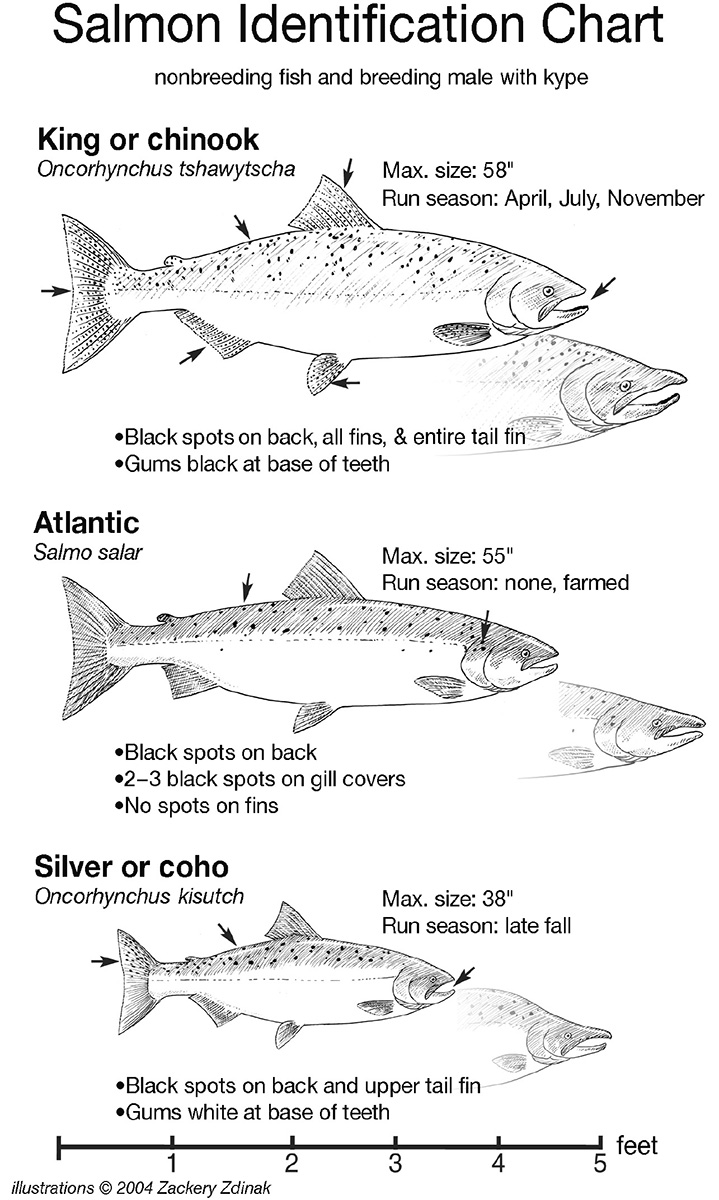
APPENDIX D: SALMON AND MUSTELID VARIETIES IDENTIFICATION CHARTS
The British class system is so complex even the British
don’t understand it, and will spend days debating
just which class they, and their ancestors, are in.
—UNKNOWN
The Salmon Chart
“Salmon” is an imprecise vernacular term that refers to an ancient, broad, and deep fish lineage. Even the word is old, having come into English from the Old French saumon after the Norman invasion of England in 1066. Most salmon are anadromous: that is, they breed in fresh water, the baby salmon migrate downstream to spend part of their lives in the sea, and then return to spawn in the freshwater streams where they were born.
The Atlantic salmon, Salmo salar, is the largest. Although they average about 15 pounds, specimens of more than 100 pounds have been caught. Unlike Pacific salmon, Atlantic salmon do not always die after spawning and may live to reproduce many times. It is the only species of salmon successfully domesticated so far, and there are several aqua-culture operations growing Atlantic salmon along the British Columbia sections of the Inside Passage.
Pacific salmon spawn only once and die after depositing and fertilizing their eggs. The Chinook or king salmon, Oncorhynchus tshawytscha, is the largest of the Pacific species. Chinooks average about 20 pounds, but specimens of nearly 100 pounds have been caught.
Observant readers of the Salmon Identification Chart might note that the scientific names of all the different salmon start with Oncorhynchus except for one, which starts with Salmo. Aren’t they all salmon? Even more confusingly, both the sockeye and kokanee have the same scientific name. Aren’t they different?
Taxonomic names usually note only the genus and species. Implicitly preceding the genus designation is the family; additionally, oftentimes a subspecies follows the species designation. All the salmon on the chart belong to the Salmonidae family which, by the way, contains six genera: Salvelinus (chars), Hucho (the huchen), Cristivomer (Great Lakes “trouts”), Brachymistax (the iconnus of Siberia), Oncorhynchus (Pacific salmon—including the Asian salmon, Oncorhynchus masou—and rainbow trout), and Salmo (Atlantic salmon and other trout). So yes, they are all “salmon.”
Subspecies (a.k.a. race), was coined to differentiate among sub-populations of a species where incipient speciation was evident or suspected. Up until very recently, the kokanee and sockeye had separate subspecies names and a chart like this one would have included them. But for a variety of reasons, the whole concept of subspecies is undergoing revision and, for now, there is no third appellation to distinguish the kokanee from the sockeye. But don’t worry, they really are different.


The Mustelid Chart
Mustelids are a large, widely distributed family of rather small, active, carnivorous mammals with thick, silky fur; long bodies; and short legs—and anal glands emitting a fetid odor. The mustelid identification chart is included because sightings of some mustelids are quite common along the Inside Passage, and accurate ID is difficult on the fly. Additionally, the less common mustelid sightings, such as the wolverine, still require identification. The chart is by no means encyclopedic: some mustelids such as the skunk and badger are not included because, due to their familiarity, they are seldom confused with any other animal.

